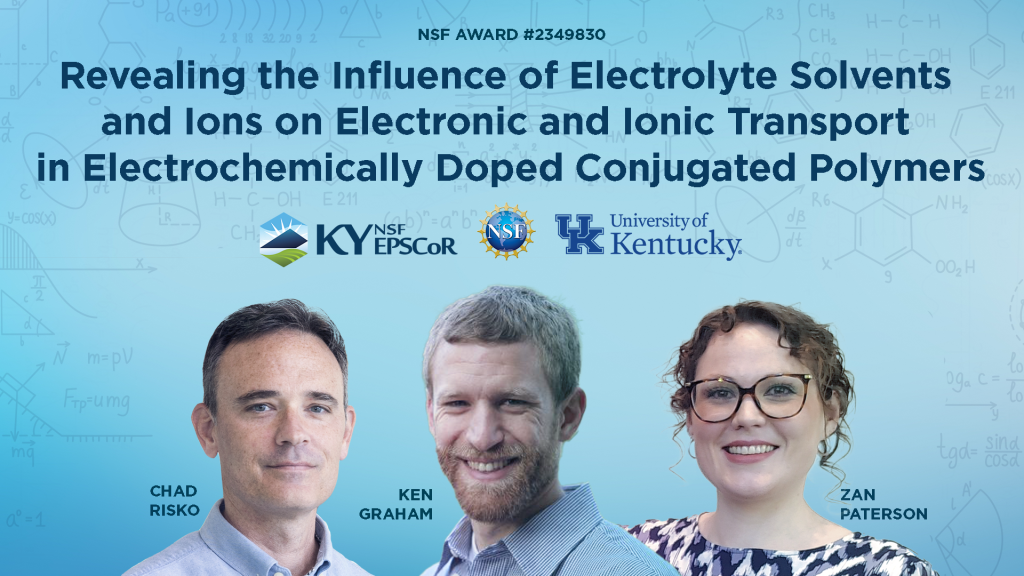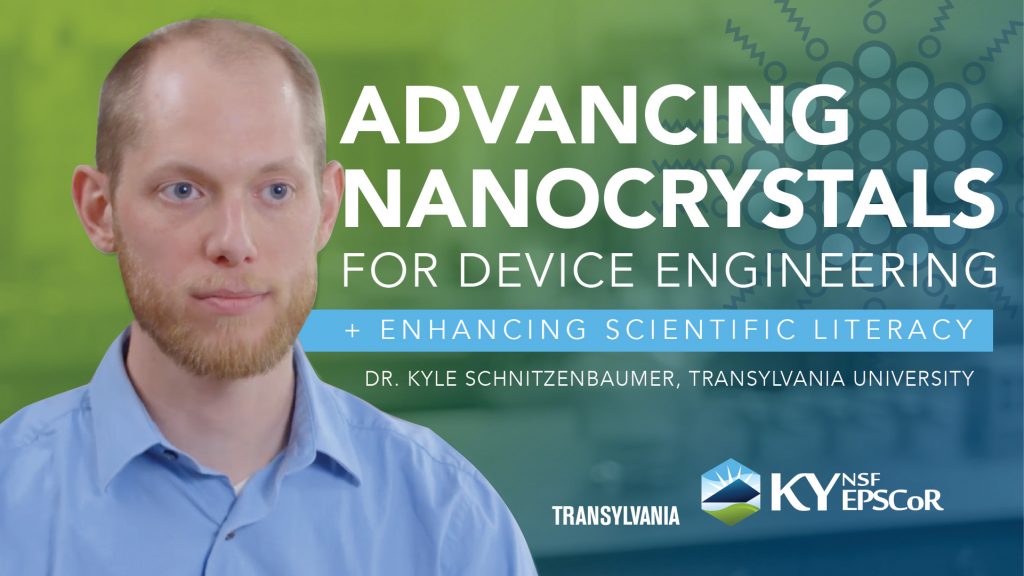As KY NSF EPSCoR’s five-year project—Kentucky Advanced Manufacturing Partnership for Enhanced Robotics and Structures (KAMPERS)—nears completion, it is crucial to highlight not only the accomplishments under the Track-1 award but also to feature follow-on awards, which will continue to push scientific innovation. As KY NSF EPSCoR program director Rodney Andrews emphasized in year one, “This is really not a five-year research project—it’s an investment over five years to carry on through the future.” KY NSF EPSCoR seeks to advance, encourage, and develop long-term improvements in scientific discovery, innovation, and education throughout the Commonwealth. The latest NSF award granted to the University of Kentucky, Revealing the Influence of Electrolyte Solvents and Ions on Electronic and Ionic Transport in Electrochemically Doped Conjugated Polymers, is an investment in research and outreach aligning with that mission.
Electricity has transformed the way we live, work, and innovate. It powers our lives, from the conveniences of modern life to the way our bodies function. And, in a globally connected world, it allows us to communicate in an instant serve as a catalyst of scientific progress. How electricity moves differs depending on the material. In living organisms, charged atoms or molecules, known as ions, flow through biological tissue. In electronics like computers and smartphones, negatively-charged electrons and positively-charged holes flow through semiconductors. Both forms of conductivity are vital for human progress.
Some materials conduct both ions and electrons—connecting the world of electronics with the world of biology. One promising group of materials, mixed ionic and electronic conductors, can be comprised of a blend of semiconducting polymers and charge-balancing electrolytes. These are biocompatible and flexible materials that have potential applications in wearable and implantable devices, as well as in developing computer systems inspired by the human brain.
However, the interconnections between polymer chemistry and electrolyte chemistry are complex and poorly understood. For these materials to reach their full potential, scientists must understand their complex chemistry and how the combination of polymer and electrolyte chemistry interact to influence ionic and electronic transport. That is where this project comes in.
An interdisciplinary team will investigate three variables that influence electronic and ionic transport, including electrolyte solvent chemistry, electrolyte ion chemistry, and polymer sidechain chemistry. They will combine material characterization, modeling, and device testing to build a thorough, predictive model that can then be utilized to guide materials design and electrolyte selection for various applications of electrochemically doped conjugated polymers (CPs).
Professor Kenneth Graham, principal investigator on the project, brings expertise in optical spectroscopies, electrochemistry, photoemission spectroscopies, and thermoelectric property characterization. Professor Alexandra Paterson brings expertise in the fabrication and characterization of organic electrochemical transistors (OECTs). Professor Chad Risko brings experience with modeling the electronic and structural properties of CPs. This suite of expertise is necessary to develop an understanding that spans from fundamental chemical interactions through device level properties and performance.
This team has worked closely before, and with success. In 2023, in work led by Paterson, the trio demonstrated key performance metrics in OECTs. (Read more about that here: http://kynsfepscor.uky.edu/paterson-group-releases-first-publication-featuring-organic-electrochemical-transistors/). The solidarity within the group is a definite strength.
The promise of this team and project is not only to create better, predictive models for CP applications, but also to contribute significantly to a greener future. CPs can be used in energy storage applications, such as batteries and supercapacitors, in photoelectrochemical devices to generate green hydrogen and convert CO2 into valuable chemicals, in thermoelectrics to convert waste heat into electricity, or in electrochromic windows to improve thermal control and decrease energy consumption for heating and cooling purposes.
Graduate students will play a large role in this project, especially in the day-to-day laboratory operations. A minimum of three students will gain proficiency in various advanced materials processing and characterization techniques, including photolithography, OECT fabrication and testing, numerous spectroscopies, and/or computational chemistry. These well-trained graduates will contribute to strengthening the STEM workforce in Kentucky and across the globe.
In addition to scientific innovations, this project will also fund outreach events to promote STEM education in Kentucky, with particular hope to reach rural Appalachian Kentucky. The idea comes from feedback received during workshops held by Graham in previous years, where high school teachers came to UK to learn about advanced materials and gain hands-on device fabrication experience in devices that are directly relevant to real world technologies. These devices included organic light emitting diodes (currently in most cell phones), solar cells, and electrochromic devices (currently used in car mirrors and airplanes). Teachers will also learn how to conduct simple electronic experiments with their students and be introduced to computer programming tools to explore the electronic and geometric structures of certain molecules, making science more accessible and engaging.
“The science workshops will equip teachers with the expertise, learning materials, and components necessary to perform hands-on experiments to teach their students about the role of science and engineering in their everyday lives,” says Graham. “While the three of us have in-depth knowledge of the science and engineering that goes into these devices, we look forward to working with the middle and high school teachers to make learning modules and activities as accessible and exciting as possible for incorporation into their classes.”
Additionally, the project will develop educational modules for educators covering a range of STEM subjects including thermal energy, lighting technology, transistors, and computational chemistry. These modules will feature instructional videos, hands-on activities, and experiments aligning with real-world applications and even economic considerations, enhancing the relevance for students. The training that the middle and high school teachers receive combined with the plug-and-play modules will impact approximately 2,000 middle and high school students annually in Kentucky, a number that will proliferate over time, enhancing the long-term scientific knowledge pool in the Commonwealth.
“On behalf of the team, I want to thank NSF for this impactful grant,” says Graham. “This investment will have lasting benefits for the research community, the University, and the state of Kentucky.”




